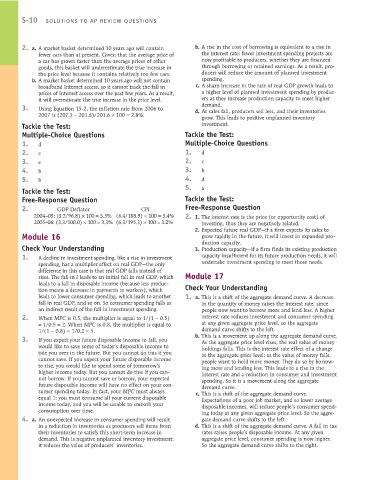Page 856 - Krugmans Economics for AP Text Book_Neat
P. 856
S-10 SOLUTIONS TO AP REVIEW QUESTIONS
2. a. A market basket determined 10 years ago will contain b. A rise in the cost of borrowing is equivalent to a rise in
fewer cars than at present. Given that the average price of the interest rate: fewer investment spending projects are
a car has grown faster than the average prices of other now profitable to producers, whether they are financed
goods, this basket will underestimate the true increase in through borrowing or retained earnings. As a result, pro-
the price level because it contains relatively too few cars. ducers will reduce the amount of planned investment
b. A market basket determined 10 years ago will not contain spending.
broadband Internet access, so it cannot track the fall in c. A sharp increase in the rate of real GDP growth leads to
prices of Internet access over the past few years. As a result, a higher level of planned investment spending by produc-
it will overestimate the true increase in the price level. ers as they increase production capacity to meet higher
3. Using Equation 15-2, the inflation rate from 2006 to demand.
2007 is (207.3 − 201.6)/201.6 × 100 = 2.8%. d. As sales fall, producers sell less, and their inventories
grow. This leads to positive unplanned inventory
Tackle the Test: investment.
Multiple-Choice Questions Tackle the Test:
1. d Multiple-Choice Questions
2. c 1. d
3. e 2. c
4. b 3. b
5. b 4. d
5. a
Tackle the Test:
Free-Response Question Tackle the Test:
2. GDP Deflator CPI Free-Response Question
2004–05: (3.2/96.8) × 100 = 3.3% (6.4/188.9) × 100 = 3.4% 2. 1. The interest rate is the price (or opportunity cost) of
2005–06: (3.3/100.0) × 100 = 3.3% (6.3/195.3) × 100 = 3.2% investing, thus they are negatively related.
2. Expected future real GDP—if a firm expects its sales to
Module 16 grow rapidly in the future, it will invest in expanded pro-
duction capacity.
Check Your Understanding 3. Production capacity—if a firm finds its existing production
1. A decline in investment spending, like a rise in investment capacity insufficient for its future production needs, it will
spending, has a multiplier effect on real GDP—the only undertake investment spending to meet those needs.
difference in this case is that real GDP falls instead of
rises. The fall in I leads to an initial fall in real GDP, which Module 17
leads to a fall in disposable income (because less produc- Check Your Understanding
tion means a decrease in payments to workers), which
leads to lower consumer spending, which leads to another 1. a. This is a shift of the aggregate demand curve. A decrease
fall in real GDP, and so on. So consumer spending falls as in the quantity of money raises the interest rate, since
an indirect result of the fall in investment spending. people now want to borrow more and lend less. A higher
2. When MPC is 0.5, the multiplier is equal to 1/(1 − 0.5) interest rate reduces investment and consumer spending
= 1/0.5 = 2. When MPC is 0.8, the multiplier is equal to at any given aggregate price level, so the aggregate
1/(1 − 0.8) = 1/0.2 = 5. demand curve shifts to the left.
3. If you expect your future disposable income to fall, you b. This is a movement up along the aggregate demand curve.
would like to save some of today’s disposable income to As the aggregate price level rises, the real value of money
holdings falls. This is the interest rate effect of a change
tide you over in the future. But you cannot do this if you in the aggregate price level: as the value of money falls,
cannot save. If you expect your future disposable income people want to hold more money. They do so by borrow-
to rise, you would like to spend some of tomorrow’s ing more and lending less. This leads to a rise in the
higher income today. But you cannot do this if you can- interest rate and a reduction in consumer and investment
not borrow. If you cannot save or borrow, your expected spending. So it is a movement along the aggregate
future disposable income will have no effect on your con- demand curve.
sumer spending today. In fact, your MPC must always c. This is a shift of the aggregate demand curve.
equal 1: you must consume all your current disposable Expectations of a poor job market, and so lower average
income today, and you will be unable to smooth your disposable incomes, will reduce people’s consumer spend-
consumption over time.
ing today at any given aggregate price level. So the aggre-
4. a. An unexpected increase in consumer spending will result gate demand curve shifts to the left.
in a reduction in inventories as producers sell items from d. This is a shift of the aggregate demand curve. A fall in tax
their inventories to satisfy this short -term increase in rates raises people’s disposable income. At any given
demand. This is negative unplanned inventory investment: aggregate price level, consumer spending is now higher.
it reduces the value of producers’ inventories. So the aggregate demand curve shifts to the right.

